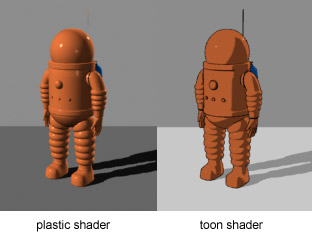Mastering the 5 Types of Shading Techniques for Animation
In the world of animation, mastering the art of shading is as crucial as the storyline or the characters themselves.
Shading, the process that breathes life and depth into animations, can transform a flat image into a vivid, three-dimensional masterpiece.
Different types of shading techniques offer a variety of textures and effects, each capable of narrating a unique visual story.

Cover GIF via GIPHY
In this blog post, we delve into the five essential types of shading in animation, guiding you on how to use them effectively to enhance your animations.
Whether you are a budding animator or an experienced professional, understanding these techniques is key to elevating your craft and bringing your animated worlds to life.
The Basics of Shading in Animation
Shading in animation is more than just a finishing touch; it's a fundamental element that adds dimension, emotion, and realism to your creations.
At its core, shading is about depicting how light interacts with surfaces and objects in a scene. This interaction is crucial in animation, as it helps convey the mood, time of day, and even the weather, thereby enriching the storytelling.
The Impact of the Different Types of Shading
Understanding shading begins with recognizing its impact. It's not just about darkness and light; shading shapes perception.

GIF by davestrick via GIPHY
It can make a character appear soft and gentle, or rugged and intense. It can make environments feel warm and inviting or cold and forbidding. This powerful tool in an animator's arsenal is essential for creating a visually compelling narrative.
In the upcoming sections, we'll explore five specific types of shading that are commonly used in animation. Each of the types of shading has its unique application and aesthetic, offering a range of possibilities for animators to express their artistic vision.
Type 1: Flat Shading
Flat shading is one of the most fundamental types of shading used in animation.
Characterized by its simplicity, flat shading utilizes single tones and colors without gradients, giving a clean, minimalistic look. This is one of the types of shading that is especially popular in styles where simplicity is key, such as in certain forms of 2D animation and motion graphics.
The power of flat shading lies in its ability to convey clear, readable forms and emotions without the complexity of detailed light and shadow. It's an excellent choice for projects with a stylized aesthetic or when working under tight deadlines.

Image via ResearchGate
Additionally, flat shading can be a great starting point for beginners who are just getting to grips with the basics of shading in animation.
Main Takeaway
When using flat shading, it's important to choose your colors wisely. Since there are no gradients or shadows to add depth, the color choice will play a significant role in defining the mood and atmosphere of the scene.
Type 2: Cel Shading
Cel shading, a technique often seen in various types of animation, particularly in the realm of video games and graphic novels, offers a unique and stylized look.
This method is renowned for its ability to mimic the characteristics of hand-drawn illustrations, giving a distinctive edge that stands out in the digital world.
What sets cel shading apart among the types of shading is its utilization of distinct shadows and highlights without gradation, creating a high-contrast, dramatic effect.

Image via Wikipedia
This technique is particularly effective in emphasizing dynamic movements and expressions, making it a favorite for animators aiming to create energetic and lively scenes.
Implementing cel shading requires a keen eye for how light interacts with objects, as the shadows and highlights are typically more exaggerated than in real life.
The key is to strike a balance between realism and artistic expression, using bold colors and sharp contrasts to bring characters and scenes to life.
Main Takeaway
For animators looking to add a comic book or graphic novel feel to their work, cel shading is an excellent choice. It allows for creative freedom while still maintaining a sense of depth and dimension in the animation.
Type 3: Smooth Shading
Smooth shading is a technique widely used in various types of animation to achieve a more realistic and three-dimensional look.
This style is characterized by its seamless gradients and subtle transitions between colors, which mimic the way light naturally falls and reflects off surfaces.
In smooth shading, the focus is on creating a gradual change from light to dark, avoiding harsh lines or abrupt changes in tone.
Image via courses.washington.edu
This is one of the types of shading that is ideal for rendering lifelike textures and forms, such as human skin, fabrics, or natural landscapes. It adds depth and volume to the objects and characters, making them appear more tangible and relatable.
The technique requires a meticulous approach to light and shadow, demanding a good understanding of how light behaves in the real world.
For animators, mastering smooth shading involves not just technical skills but also an artistic sense to subtly manipulate light and shadows for a natural effect.
Main Takeaway
Smooth shading is one of the more effective types of shading in animations that aims to convey a sense of realism, whether in 3D animation or more detailed 2D works. It enhances the viewer's immersion, drawing them deeper into the animated world with its lifelike quality.
Type 4: Hatching and Cross-Hatching
Hatching and cross-hatching are artistic techniques that have been adapted into various types of shading in animation, particularly in styles that emulate traditional drawing or etching.
These methods involve creating tones and textures through a series of closely spaced parallel lines (hatching) or by adding another set of lines in a different direction (cross-hatching).
In animation, hatching and cross-hatching are used to add depth and dimensionality, especially in scenes that require a more tactile or handcrafted feel.
Video via YouTube
These types of shading are excellent for emphasizing the form and contours of objects, as well as for depicting light and shadow in a more stylized manner.
Hatching can be used to create a sense of movement and direction, guiding the viewer’s eye through the animation.
Cross-hatching, with its intersecting lines, is ideal for creating darker tones and more intricate textures.
Both methods require a strategic approach to line placement and density, as these factors significantly impact the overall effect and mood of the animation.
Main Takeaway
While these techniques might appear more traditional, they are still highly relevant in modern animation, particularly in projects that seek a unique, artistic, or slightly abstract aesthetic.
They offer animators a way to infuse their work with a sense of craftsmanship and artistic flair.
Type 5: Gradient Shading
Gradient shading is a versatile and powerful technique in various types of animation, capable of adding a dynamic range of depth and emotion to scenes.

Image via Icons8 Blog
This is among the types of shading that uses gradual transitions between colors and tones, creating a smooth, almost ethereal effect that can evoke a range of emotions and atmospheres.
In gradient shading, the key is to understand how to blend colors effectively to simulate the subtle nuances of light and shadow.
This technique can be used to create stunning skies and reflective surfaces, or to give a scene a particular time of day feel. It's particularly effective in scenes that require a dramatic or atmospheric mood.
One of the advantages of gradient shading is its flexibility. It can be used in both realistic and stylized animations. In realistic settings, it helps to create a sense of depth and volume, while in stylized animations, it can add a unique and creative flair.
Main Takeaway
For animators, mastering gradient shading involves not only technical skill but also an artistic eye for color harmony and balance.
These types of shading can make your animations stand out, adding a layer of sophistication and visual appeal that draws viewers into the animated world.
Unleashing Creativity with the 5 Types of Shading

GIF via GIPHY
In conclusion, understanding and utilizing the different types of shading in animation is crucial for any animator seeking to enhance their storytelling and visual impact.
From the simplicity of flat shading to the depth of smooth shading, and from the texture of hatching to the drama of cel shading and the subtlety of gradient shading, each technique offers unique opportunities for creative expression.
If you’re an animator who’s looking to start your own studio or grow your career, check out our blog on How to Start an Animation Studio and GET FREE TRAINING to kickstart your animation career today.



